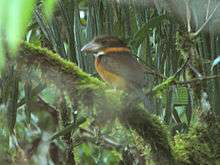Shovel-billed kookaburra
The shovel-billed kookaburra (Clytoceyx rex), also known as the shovel-billed kingfisher, is a large, approximately 33 cm (13 in) long, dark brown tree kingfisher with a heavy, short and broad bill that is unique among the kingfishers. It has a dark head with rufous stripe behind eye, a white throat, rufous neck collar and underparts, bright blue rump, brown iris, brownish-black bill with paler mandible (entire bill often appears brownish due to earth) and pale feet. Both sexes are similar in appearance, but are easily recognized from the colour of the tail. The male has a dark bluish tail while female's is rufous. The juvenile has a female-like plumage with scale-patterned feathers.
| Shovel-billed kookaburra | |
|---|---|
 | |
| Scientific classification | |
| Kingdom: | Animalia |
| Phylum: | Chordata |
| Class: | Aves |
| Order: | Coraciiformes |
| Family: | Alcedinidae |
| Subfamily: | Halcyoninae |
| Genus: | Clytoceyx Sharpe, 1880 |
| Species: | C. rex |
| Binomial name | |
| Clytoceyx rex Sharpe, 1880 | |
The sole representative of the genus Clytoceyx, the shovel-billed kookaburra is endemic to New Guinea. It primarily occurs in hill forests, but has been recorded from sea-level up to an altitude of 2400 m (7850 ft). It finds its food in mud or on moist ground. The diet consists mainly of earthworms, snails, beetles, lizards and insects. It is inconspicuous and infrequently seen. It is likely that it is partially crepuscular.
A molecular phylogenetic study published in 2017 found that the shovel-billed kookaburra nested with the kookaburras in the genus Dacelo.[2]
Widespread but uncommon throughout a large part of New Guinea, the shovel-billed kookaburra is evaluated as Least Concern on the IUCN Red List of Threatened Species.
References
- BirdLife International (2012). "Clytoceyx rex". IUCN Red List of Threatened Species. 2012. Retrieved 26 November 2013.CS1 maint: ref=harv (link)
- Andersen, M.J.; McCullough, J.M.; Mauck III, W.M.; Smith, B.T.; Moyle, R.G. (2017). "A phylogeny of kingfishers reveals an Indomalayan origin and elevated rates of diversification on oceanic islands". Journal of Biogeography: 1–13. doi:10.1111/jbi.13139. "Early View" version
External links
- BirdLife Species Factsheet
- Photos and brief description of first known nest. Accessed 2008-07-10.
